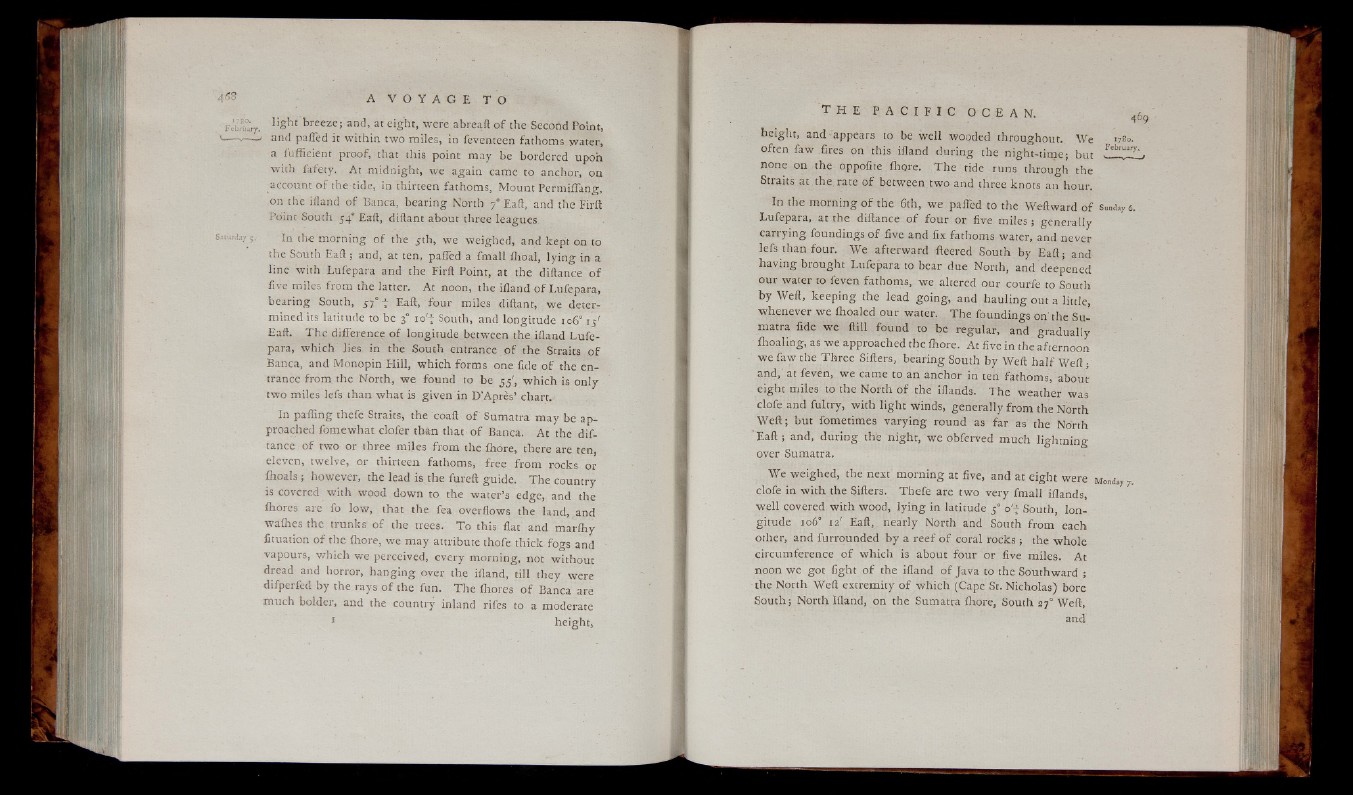
i pu''"1 , t );£ht breeze; and, at eight, were abreaft o f the Second Point,
|— *— f| and paffed it within two miles, in feventeen fathoms water,
a iufficient proof, that this point may be bordered upon
with fafety. At midnight, we again came to anchor, on
account o f the tide, in thirteen fathoms, Mount Permiffang,
on the iiland o f Banca, bearing North f Eaft, and the Firft
Point South 54° Eaft, diftant about three leagues.
In the morning o f the 5th, we weighed, and kept on to
the South Eaft ; and, at ten, palled a fmall ilioai, ly in g in a
line with Lufepara and the Pirft Point, at the diftance o f
five miles from the latter. At noon, the iiland o f Lufepara,
bearing South, 57° t Eaft, four miles diftant, we determined
its latitude to be 3° io'J South, and longitude 106° 15'
Eaft. The difference o f longitude between the.ifland Lufepara,
which lies in the South entrance o f the Straits o f
Banca, and Monopin Hill, which forms one fide o f the entrance
from the North, we found to be 55', which is only
two miles lefs than what is given in D’Après’ chart.;
In pa fling thefe Straits, the coaft o f Sumatra may be approached
fomewhat clofer than that o f Banca. At the diftance
o f two or three miles from the flidre, there are ten,
eleven, twelve, or thirteen fathoms, free from rocks or
ihoals ; however, the lead is the fureft guide. The country
is covered with wood down to the water’s edge, and the
Ihores are fo low, that the fea overflows the land, and
walhes the trunks o f the trees. To this flat and marfliy
fituation o f the Ihore, we may attribute thofe thick fogs and
vapours, which we perceived, every morning, not without
dread and horror, hanging over the iiland, till they were
difperfed by the rays o f the fun. The Ihores o f Banca are
much bolder, and the country inland rifes to a moderate
1 height,
height, and-appears to be well wooded throughout. We 1780.
often faw fires on this iiland during the night-time; but
none on the oppofite ihore. The tide runs through the
Straits at the, rate o f between two and three knots an hour.
In the morning o f the 6th, we paffed to the Weftward o f Sundays.
Lufepara, at the diftance o f four or five miles ; generally
carrying foundings o f five and fix fathoms water, and never
lefs than four. We afterward fleered South by Eaft; and
having brought Lufepara to bear due North, and deepened
our water to feven fathoms, we altered our courfe to South
b y Weft, keeping the lead going, and hauling out a little,
whenever we ihoaled our water. The foundings on the Sumatra
fide we ftill found to be regular, and gradually
ihoaling, as we approached the ihore. At five in the afternoon
we faw the Three Sifters, bearing South by Weft h a lf Weft;
and, at feven, we came to an anchor in ten fathoms, about
eight miles to the North o f the iilands. The weather was
clofe and fultry, with light winds, generally from the North
W e ft; but fometimes varying round as far as the North
Eaft; and, during the night, we obferved much lightning
over Sumatra.
We weighed, the next morning at five, and at eight were Monday T.
clofe in with the Sifters, Thefe are two very fmall iilands,
well covered with wood, ly in g in latitude 5° o 'f South, longitude
106° 12' Eaft, nearly North and South from each
other, and furrounded by a re e f o f coral rocks ; the whole
circumference o f which is about four or five miles. At
noon we got light o f the iiland o f Java to the Southward ;
the North Weft extremity o f which (Cape St. Nicholas) bore
South; North Iiland, on the Sumatra ihore, South «7° Weft,
and